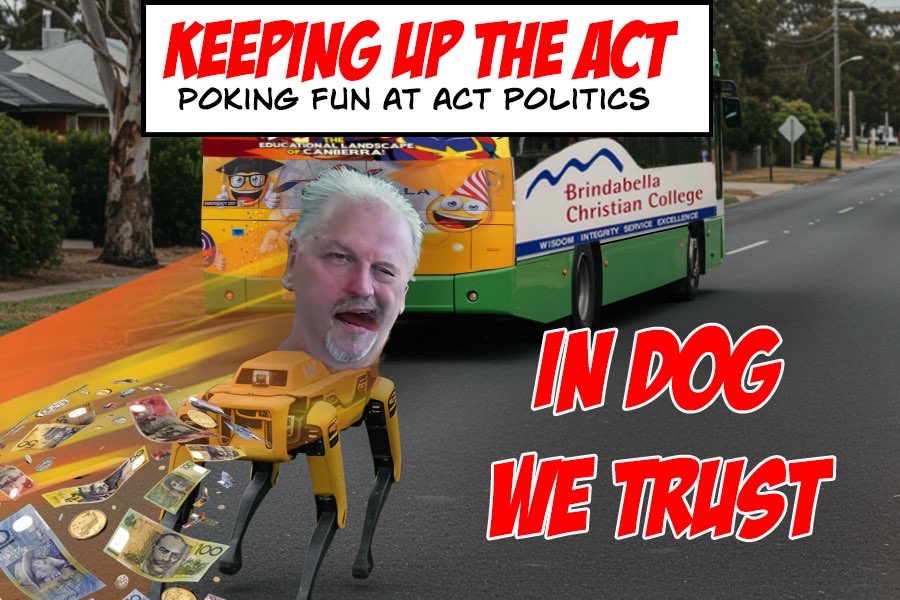“It’s a trap in the system that Canberrans should be alert to,” says community leader DR DAVID DENHAM. “Knock-down rebuilds often cause concern, but this means, in effect, that decisions on knock-down rebuilds of single dwellings in Canberra cannot be scrutinised, even if they have a DA.”
The Griffith Narrabundah Community Association has been tricked by the Territory Planning Authority (TPA) into paying its members’ money for a review that was never available to it.

Most knock-down rebuilds are exempt developments and don’t have a DA or review by ACAT, but some are required to go through the DA process.
A DA was notified on the TPA website, and the GNCA had concerns about its compliance with the law, so it applied to ACAT for a review of the decision. The quick decision on the DA said it was a publicly notified decision and third-party objectors had a right of review.
The GNCA contacted the TPA three times to discuss its concerns but got no reply, so it paid the ACAT application fee, and a directions hearing was listed. Three days before the hearing the government solicitors, acting for the TPA, told the GNCA they had no right of review and should withdraw. Gotcha!
The GNCA did not withdraw, but ACAT dismissed its application because the DA did not need to be publicly notified – although it had been. Under the rules in a schedule to the new Planning Act, ACAT didn’t have jurisdiction to review the GNCA’s application.
It turns out that there is a new regulation that enables the right to review to be removed by prescribing that a DA does not have to be publicly notified. And that regulation, combined with the schedule, takes away the review rights given under the current act.
It’s a trap in the system that Canberrans should be alert to. Knock-down rebuilds often cause concern but this means, in effect, that decisions on knock-down rebuilds of single dwellings in Canberra cannot be scrutinised, even if they have a DA.
A tender has been released for an Independent Planning Advisory Service (IPAS), but it doesn’t operate yet.
Hopefully it will help ordinary citizens navigate this very confusing system, but in the meantime think carefully about parting with your hard-earned cash if it is a knock-down rebuild of any kind.
Even if it is non-compliant and the TPA decision tells you that it has been publicly notified and that you have review rights.
The GNCA has published details on its website to assist other Canberrans.
Dr David Denham, president, Griffith Narrabundah Community Association
Why the tram bridge over lake will never be built
The tram saga rolls on and on, and gets worse and worse.
So, as pointed out by Dr Douglas Mackenzie and announced in the latest edition of Our CBR, it is planned to demolish the northbound span of the Commonwealth Avenue Bridge, and replace it with a new rail bridge and new road bridge. This is because, as I pointed out in previous letters, the gap between the existing road bridges is not wide enough for the rails.
This scheme is beyond the financial capacity of both the ACT and Federal governments, and like many government projects around the world, will remain uncompleted.
Why do I say this? Can’t both governments keep borrowing billions without limit?
I shall explain from the point of view of a monetary economist. Nowadays, government borrowing is done by printing money; the Reserve Bank issuing new money, that is paid to banks that, in turn, are asked to go through a sleight of hand by using this money to buy “government debt”.
It is all an illusion to prevent people questioning why they are being robbed. Anyway, this illusion is nearly over. A measure of this illusion, called velocity, is now very nearly zero.
When it reaches zero, soon, the dollar won’t head for hyperinflation, it will just cease to exist.
As a consequence, besides governments being forced to balance their books, they will not be able to borrow and spend until a new market for government debt is created. We will be back to the equivalent to the Gold Standard. A currency beyond the control of the government.
As for this wretched bridge, it will be left half completed for many generations. A lesson for all subsequent governments.
Tim Walshaw, Watson

12 degrees and millions in cost
In my letter on light rail stage 2B (CN May 30), I referred to the billions in cost to replace the northbound span of Commonwealth Avenue Bridge. I also referred to the “indirect costs of up to nine years of severe road traffic disruption between Commonwealth Park and Woden”.
I clearly recall when, in March-April 2023, the approaches to the Kent Street bridge were modified to include traffic lights causing six weeks of traffic congestion and chaos. It was not a large and complex construction problem.
Fortuitously, on citynews.com.au, the editor included an artist’s impression of the light rail stop at Kent Street on the Adelaide Avenue. It is evident that, compared to the photograph, the gradient of the median strip of Adelaide Avenue has mysteriously declined from about 12 degrees to near-horizontal, leaving the central pier untouched.
In the real world, this result would have involved a huge amount of excavation and earthmoving, possibly the replacement of the central pier, many months of traffic disruption, and the expenditure of many more millions: for just one of many problems.
Where is the benefit–cost analysis?
Dr Douglas Mackenzie, Deakin
Using the obfuscation argument on tram costs
Douglas Mackenzie (letters, CN June 30) uses the obfuscation argument (too many references to cite sources) to refute my criticism of his extraordinarily inaccurate claims of up to $8-$10 billion for the Stage 2B tram to Woden.
Justifying his views by just quoting estimates of others, the validity of which is questionable, says little of his research. In fact, NO decision has been made to demolish the western bridge on Commonwealth Avenue to provide for as he claims, “replacement road bridge and new rail bridge” at again, his wild estimate of “multi billions”! The public comments on the engineering-derived concepts for 2B and crossing the lake closed on June 30.
To put costs into a realistic perspective, the total cost for Stage 1 from Gunghalin to the city, including all the works, the trams, the depot and 13 stations was audited at $675 million, $108m under budget. The letter “b” does not appear.
Unfortunately, most have no idea of how big one billion dollars really is. Bluntly, if you spent $10,000 every day, you would spend one billion in 274 years!
So, Douglas, by all means express your views on the tram, but please use facts not unscientific WAGs.
Dave Rogers, Woden
Sick of the protesting students’ antics
I am heartily sick and tired of the antics of many university students demonstrating over Palestine.
They are supposed to be attending university to learn and for overseas students, to return and improve their own country’s economies and standard of living.
If their demonstrations showed some evenness in criticising both Hamas and Israel for the turmoil in Palestine, then I would be more understanding, but this has not been the case.
When I was working in one of the Commonwealth mega departments, I was tasked with the job of setting up its Graduate Recruitment Program and interviewing and selecting participants.
If any of those students demonstrating aggressively at the ANU were to apply, I can assure you that they would have got short shrift from me. I wanted graduates who would put their heads down to learn and work and who would co-operate with fellow staff to improve the performance of the department. Trouble makers would certainly not have been welcome.
Ric Hingee, Duffy
Humane action still needed now
Carole Ford’s compassionate and insightful letter, about how no one should be forced to face and endure the physical and mental horrors of dying from dementia and similar conditions, should be essential reading for all current and future Assembly MLAs (CN “Where is the mercy when there is nothing left?”, June 5).
Now that ACT’s Voluntary Assisted Dying bill has passed into law, let’s see who is willing to commit to act in the right and humane direction on this key VAD eligibility gap, and give it the time and priority it deserves well before the implementation of VAD in November 2025.
Sue Dyer, Downer
Thanks for help with a heavy parcel
I would like to publicly thank the young woman who showed kindness and generosity of spirit when she offered to drive me, an older woman, home from the post shop where I was collecting a large, heavy parcel.
In an exploitative world it is heartwarming to know that some people stand out with positive and generous social values. Kindness is often overlooked. I thank her very much.
Jenny Holmes, Weston
Letters to the Editor Party anyone?
With an election looming, it’s a good time to remember our earliest election, which involved parties such as the Sun-dried Warm Tomato Party, the No Self Government Party and the Party Party Party.
Now, with “Independents” forming their own group, following the success of David Pocock in the Senate, this must be the right time to broaden our horizons and consider another viable group, temporarily titled The Letters to the Editor Group or Party.
There are just SO MANY potential candidates, prolific writers with such positive and varied views as to the direction in which Canberra should be heading. Their combined presence in our local government would be both intriguing and absolutely invaluable.
The new group, or party, could be headed by such an eminent writer as Dr Douglas McKenzie, with valued support from other residents with strong views and credible suggestions, such as Vi Evans, Rick Hingee, Ian Pilsner, Eric Hunter, Max Flint, and others with a wealth of knowledge and understanding, such as Julie Tongs and, of course, Colliss Parrett.
How about it folks? How about you all get together for a round table chat, discuss tactics, and make history?
Max McGregor, via email
Get ready for the spin on smart meters
I’ve just made a submission on smart meters to the Australian Energy Market Commission (AEMC).
AEMC is currently looking at accelerating smart meter deployment in NSW, Queensland, the ACT and SA, following a request from industry players Intellihub, SA Power Networks and Alinta Energy.
Smart meters are promoted by industry and regulators as the best thing since sliced bread.
However, the replacement of electromechanical meters with digital technology has resulted in locking consumers into a continuing cycle of higher electricity bills.
Accumulation meters have a long lifespan, whereas smart meters need to be replaced over time. Smart meters also depend on sophisticated technology, requiring communication networks, data storage, software applications and technical expertise.
Research released by The Australia Institute in 2019 showed that “time of use pricing” facilitated by smart meters drives up household energy costs. Electricity companies and regulators push for higher electricity prices at peak times, as well as higher “shoulder” periods. In theory, this encourages people to move their energy consumption to times of the day when it is cheaper for utilities to provide it.
The Australia Institute concluded that many households have now exhausted their capacity to cut electricity consumption or change their time of electricity use. In reality, electricity companies are using electricity demand peaks to push for higher consumer prices to increase their profits.
The call to accelerate the smart meter rollout is clearly about industry interests over that of consumers. Get ready for more spin saying it’s all about the advantages for consumers. Guess who is paying?
Murray May, Cook
How intolerant our society has become
Sue Dyer’s letter on euthanasia (CN May 30) reminded me how intolerant our society has become while at the same time passing reams of legislation to protect its own progressive behaviour from criticism. How dare some Liberal parliamentarians even express reservations about the proposed euthanasia legislation!
Those who quote the severely disabled or people suffering dementia or other incurable illness in the context of euthanasia, often have a preconception of a life lived so as a life of “poor quality”. In reality, if disabled people describe their own lives in negative terms it is often because of the environmental responses of rejection they have to deal with.
That palliative care is a more considered means of alleviating the suffering of a stricken person while enabling those near and dear to express their love is not mentioned.
John L Smith, Farrer
Knights in shining armour are on the way
I thank Joe Prevedello for responding (letters, CN May 23) to my letter (CN May 16) inquiring into his credentials as a Liberal candidate for Ginninderra in October’s election and asking about his knowledge of economics.
The latter is important given that the Sheriff of Nottingham (Barr) is a bit wobbly on such matters. The former is important because when the government-in-waiting jams your letterbox with educational material advising new knights in shining armour are on the way, it’s important we look for rust and reach for the WD40 can.
I already have a tongue-in-cheek for you and Mark Parton:”Sledge and Hammer” and look forward to your contributions straightening the place out. Heaven knows it needs it. I trust wise heads vote you both into office so we can be rescued.
John Lawrence via email
No apologies for being human and ‘crying’
Well, haven’t I received a working over from CityNews letter writers over the last couple of weeks? Jeez, Louise!
Collis Parrett (Letters, May 16) disagreed with the research I provided regarding alcohol being the major cause of death of those who abuse its use and went on to infer that I am “one person who still seems to support our illicit drug policy”. I am confident I’m not.
Further, Collis wrote that there is nothing “pretty” about taking mind altering drugs. Oh contraire, I saw lots of pretty images when I indulged in mind-altering drugs, and I am here to tell the tale!
Then, there was the hiding I copped (so to speak) for my letter regarding the verbal abuse I received from an AFP officer. My letter was not about dodging a fine, I was writing about the way I was treated by the police officer who held all the power in our verbal exchange.
Further, Michael Collins (May 16) chose to compare me to Bruce Lehrmann’s behaviour in an alleged rape trial. This is simply edging close to crossing the defamation line. How ironic!
And then Ian Pilsener (May 23) wrote that I am often critical of other people who don’t share my views. Is this not freedom of speech?
I will not apologise for being human and “crying”.
Janine Haskins, Cook
Identify worst invasive plants in local areas
As plant enthusiast Julie Lindner notes, invasive weeds are a threat to endangered flora and fauna and contribute to biodiversity loss (Letters, CN June 6).
The Invasive Species Council agrees stating: “Along with climate change and habitat loss, invasive species are a leading threat to Australia’s wildlife.”
Shockingly, the council reports that the list of invasive plants in Australia is more than 2700 and increases by about 20 new species every year.
How good would it be if Australians were able to identify the worst invasive plants in their local area? ACT residents can add invasive species sightings at naturemapr.org which is monitored by the Environment, Planning and Sustainable Development Directorate.
For anyone interested in the work being done to monitor and control invasive plants in the ACT, the 2023-24 invasive plant reporting and control online interactive map at environment.act.gov.au/parks-conservation/plants-and-animals/biosecurity/invasive-plants is well worth exploring.
The Invasive Species Council at invasives.org.au/how-to-help lists a dozen volunteer organisations in the ACT alone for those wanting to get involved.
Ray Peck, Hawthorn, Victoria
Who can be trusted?
In a world of spin and confusion, there’s never been a more important time to support independent journalism in Canberra.
If you trust our work online and want to enforce the power of independent voices, I invite you to make a small contribution.
Every dollar of support is invested back into our journalism to help keep citynews.com.au strong and free.
Thank you,
Ian Meikle, editor




Leave a Reply